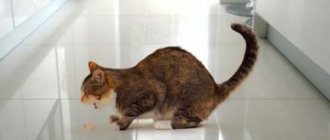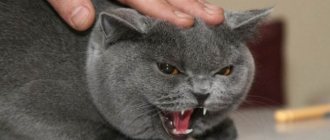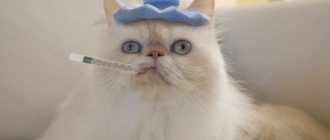Vomiting is a physiological process that develops if a cat has eaten something wrong and in a number of other cases. Cats are quite clean animals that constantly wash themselves and lick their coats; because of this, not only dirt, but also hair fibers get into the stomach. In addition, in some cases, animals eat grass and specifically stimulate the gag reflex, which helps cleanse the stomach. If the cat vomits white foam rarely, no more than 1-2 times a day, then there is nothing to worry about. But if your pet has uncontrollable vomiting, you need to urgently contact a veterinarian.
Causes of vomiting in cats
Vomiting in a cat can occur for various reasons. They can be designated as follows:
- The cat has overeated - large portions and eating too quickly quite often lead to regurgitation of excess food.
- Lumps of fur in the stomach, which form when licking the fur coat, lead to irritation of the mucous membrane and vomiting.
- Poisoning from low-quality food products.
- Cats eating indoor plants also often ends in vomiting.
- The entry of bones and foreign objects into the digestive tract leads to the release of the stomach contents.
- Gastritis is an inflammatory process of the gastric mucosa and is a common cause of nausea and vomiting in cats.
- Disruption of the pancreas leads to a deterioration in enzymatic processes during the digestion of food, and vomiting is possible.
- Volvulus or peritonitis - these pathologies are very dangerous for the animal’s life and require urgent intervention from a veterinarian.
- Diseases of the liver and gall bladder.
- Intoxication with medications or toxic substances.
- Infectious diseases - these conditions are accompanied by uncontrollable vomiting, lethargy and lack of appetite. In this case, treatment should be carried out by a doctor.
In addition, the cat may not eat anything and vomit if infected with worms. In this case, worms may be observed in the vomit, which indicates severe damage to the animal’s body.
To protect your pet from helminthic infestation, which negatively affects the entire body and significantly reduces immunity, it is necessary to give it anthelmintic once every 2-3 months. A veterinarian will help you choose the right medication.
Why does a cat vomit white foam?
A cat vomiting white foam is normal, but only if there are no impurities in the foam, and it occurs infrequently. If a cat is vomiting white foam, then a malfunction of the biliary system can be suspected. When food is digested in the stomach and enters the intestines, mucus does not cease to be released, which, upon contact with air, takes the form of white bubbles. If there is too much mucus in the digestive organs, the body reflexively pours it out.
Cats are very sensitive to nutritional errors. If a cat has not eaten for a long time, it vomits white foam. This is explained by the fact that the digestive system produces all the secretions necessary for digesting food in the usual volume. But if food does not enter the stomach for a long time, then hydrochloric acid begins to corrode the walls of the organ, resulting in irritation and vomiting. For this reason, cats should not undergo therapeutic fasting for more than one day.
It turns out that cats can also have heartburn, in this case the cat vomits foam in the morning on an empty stomach, but no other health problems are observed.
In what cases do we run to the doctor?
Seeing how their pet is suffering, owners are wondering what to do if their cat is vomiting white foam. First you need to make sure that the animal receives enough water. Then you need to observe.
In the following cases, you should also not postpone going to the doctor:
- The animal has lost interest in food. If vomiting with foam is combined with complete indifference to food, then it is necessary to check whether the animal has liver lipidosis.
- Impenetrable thirst. If a kitten drinks water without stopping, then the chances of developing pathologies in the kidneys increase.
- The cat does not urinate in the toilet, although he consumes liquid in the usual volumes.
- Vomiting occurs regularly - more than 2 times within an hour.
- The animal has a high fever and is shaking.
If you do not consult a doctor in a timely manner, then there is a possibility of a phenomenon such as chronic vomiting in cats, which will worsen the situation. Each of the described symptoms is seriously life-threatening, so it is necessary to show the animal to the doctor as soon as possible.
Useful tips from a specialist
To avoid the appearance of unpleasant and dangerous symptoms, experts recommend:
- Brush the fur regularly to prevent it from getting inside. Special brushes are used for combing.
- At the first urge, it is advisable to take the animal out onto the grass, if the weather season permits. Cats eat grass to irritate their stomach so it can empty its contents faster. It is useful to grow grass at home in a pot so that your pet can cleanse the digestive tract at any time if nausea occurs.
- To eliminate liver problems, control your diet and watch portions. For prevention, it is useful to periodically administer medications that normalize liver function.
Vomiting foam in kittens
Kittens have a weak digestive system, so vomiting can occur quite often. The main reasons for this condition look like this:
- Sudden change in diet. For example, a kitten was separated from its mother and transferred to adult food, while its small stomach is not yet able to digest roughage.
- Harmful foods - fried, smoked, spicy or simply stale - can cause vomiting in the baby.
- Persistent overeating or large pieces of food - compassionate owners try to feed their pet more satisfyingly; it seems to them that the kitten is too thin. This will not lead to anything good.
- If the kitten licks itself often, then vomiting may be a consequence of the accumulation of hair in the ventricle. This is especially true for animals with long-haired breeds.
- Accidental entry of foreign objects into the stomach. While playing, the kitten may swallow a candy wrapper, a bead, or a piece of tinsel.
- Chemical poisoning – like all babies, kittens are very curious, so they may try dishwashing liquid or litter.
- Side effects after vaccination are how the body reacts to a foreign agent entering the body.
- Congenital diseases of the liver or pancreas.
If the baby vomits, it is necessary to find out the cause of this phenomenon and eliminate it. If this condition is rarely observed, then you can observe the kitten and try to adjust the diet. When liquid, foamy vomiting is observed frequently, you need to go to a veterinary hospital.
A healthy kitten should be active and have a good appetite. If the baby is lethargic, refuses to play and eats poorly, then this is a reason to visit the doctor.
Diagnostic methods
Diagnostic methods
It is important to find out what character the vomiting has. It can be acute or chronic. To know what to do, you need to ask yourself some questions:
1. How long does vomiting last?
If your pet vomits for a long time, it could be dangerous poisoning and you need to go to the vet.
2. How often does a cat vomit?
If this is a one-time reaction, there is no need to worry. Most likely, the pet swallowed its fur or overate. But if vomiting occurs frequently, you should consult a doctor.
3. What color is the highlight?
Red vomit may indicate that your cat is bleeding from internal organs. Bile is also a bad sign.
4. What did the cat eat last?
Overeating is a common cause of vomiting. Failure to comply with feeding norms can lead to an overfilled stomach. Stale food can also be a culprit.
5. Does your cat experience seasonal shedding?
If your cat is currently shedding more than usual, she may vomit hair that she ingests while washing herself.
6. Are there any side symptoms?
Vomiting may be accompanied by diarrhea, weakness, and fever. There is a possibility that vomiting is a symptom of a dangerous disease. It is worth contacting a veterinarian.
By asking yourself these questions, you can find out the cause of nausea.
Examination of cats
To identify the cause of frequent vomiting, the veterinarian interviews the cat's owner and carefully examines the animal. If necessary, a number of studies are carried out. This approach allows you to quickly find the cause of the illness and begin to treat your sick pet. The inspection is usually carried out in several successive stages and consists of the following points:
- Interview the owner to obtain information about the frequency and duration of vomiting.
- Clarification of the cat’s diet, as well as the possibility of foreign objects entering the digestive tract.
- Determining the type and thickness of vomit, finding out information when the animal began to vomit.
- Examination of the animal, determination of general condition and reflexes.
- Clarification of information about chronic cat diseases.
If the cat has only once vomited clear liquid with a small admixture of hair, then it is worth observing the pet throughout the day. Most often, this condition stabilizes very quickly, and after a few hours the cat is playful and active. However, when vomiting becomes indomitable and the animal becomes lethargic and apathetic, dehydration sets in very quickly, which causes irreversible processes in the body. You can’t hesitate here; only a doctor can provide help. In severe cases, surgery and intravenous fluids may be needed.
The owner should be wary if the animal does not allow its belly to be touched or to be picked up. This may indicate an inflammatory process in the abdominal area.
Varieties of vomit
Very often, the cause of the illness can be determined by the color and consistency of the vomit:
- When an animal vomits a yellow foamy mass, this means that during the digestion of food a certain amount of bile enters the stomach. This is a common occurrence with gastritis, colitis and diseases of the biliary tract. Due to the release of excess bile, the liver is partially cleansed of toxins and pathogenic microorganisms. Yellowish vomiting can occur with calcivirosis, a sudden change in diet, or when a foreign body enters the stomach.
- Vomiting of clear liquid or saliva may occur with distemper. The cat may also have yellow foam, which does not contain food debris or hair fibers. With each attack of vomiting, the animal becomes worse and worse, it begins to hide from people and light. The emanating colorless liquid indicates that dehydration has begun. This condition can quickly lead to death.
- When a cat vomits right after eating, this may indicate parasites, which are often found even in pets, hair accumulated in the stomach, or poor nutrition, when the portions are too large and the food is fatty.
- Regurgitation of worms indicates a severe infection of the animal with parasites. In this case, the cat’s contact with people is limited and a course of anthelmintic treatment is carried out. The drug should be selected by a doctor based on the results of a stool analysis.
A cat who does not eat at all for more than two days and periodically vomits may be seriously ill. In this case, you need to undergo a series of tests, as well as undergo an ultrasound of the internal organs. Such vomiting is not considered physiological and indicates illness.
Vomiting blood may be the result of an insect or reptile bite. In this case, the sick animal is urgently taken to any medical facility.
Preventing the gag reflex
Preventative measures to prevent the occurrence of an unpleasant gag reflex in pets include:
- Annual vaccination, anthelmintic therapy every 3 months.
- Regular visits to the veterinarian for preventive purposes.
- Sufficient, high-quality and balanced feeding of the pet, for dessert - a special herb for cleansing and healing the cat’s body.
- Systematic care of cat hair - bathing, combing, cutting if necessary.
- Cleanliness and hygiene in the house, small items should not be in the free access of the animal.
A responsible and competent owner will always come to the aid of a sick pet, because people are responsible for those they have tamed. Knowing a lot about white foam and vomiting, its causes and consequences, you can start treatment on time, react correctly to what happened and prevent complications. Then your pet will be happy again and give a smile to others!
Pets bring joy and anxiety to their owners. Animals, like people, get sick, but cannot talk about their problems. Therefore, owners need to monitor the condition of their pets in order to come to their aid in a timely manner. If an adult cat or kitten is vomiting foam, then this is not a cause for concern, but additional care must be taken and the patient’s condition must be monitored.
How to help a cat when vomiting
You can help your cat on your own, but only if there is no high fever, diarrhea or general weakness. When such a malaise indicates poisoning, the algorithm of actions should be as follows:
- The animal is stopped feeding and provided with a sufficient amount of drink. Only water can be given; dairy products are not recommended during this period.
- The cat is given a weak solution of potassium permanganate; it can be added to drinking water or poured into the mouth from a syringe with a soft tip.
Manganese is first diluted in a small volume of water, and then added to the drink, and poured through several layers of gauze to prevent undissolved crystals from entering the stomach.
- Every two hours, the pet is given smecta dissolved in a small volume of water.
Therapeutic fasting for cats should last about 12 hours. After this, you can gradually return the cat to its normal diet. First, they adhere to a gentle diet and give boiled chicken meat, as well as strong rice water, then chicken broth or special medicinal food is introduced. After 3-4 days, the cat is transferred to standard food. Usually such actions are enough for the pet to recover and return to a full life.
When you need to see a doctor urgently
There are a number of cases when the owner does not know what to do and how to help the fluffy. First of all, you need to stop panicking, because panicking will not help the matter, and seek help from specialists. A trip to the hospital should be immediate in the following cases:
- The cat has been vomiting water or foam for more than 3 hours.
- The vomit is white or yellowish in color, but there are bloody spots in it.
- The pet refuses not only food, but also drink, and continuously vomits.
- In addition to the main symptom, diarrhea began, the animal’s nose became dry and hot, which indicates an elevated temperature. In addition, the owner should be alert to convulsions, which indicate dehydration and damage to the central nervous system.
In all these cases, you should not self-medicate, so as not to further aggravate the situation. It is better to entrust the health and life of your pet to a qualified doctor who will correctly diagnose and prescribe adequate treatment.
In some cases, cats are prescribed antibiotics to treat infectious diseases. Properly selected medications can quickly get your family pet back on his feet.
How to protect a cat from poisoning
Any disease is easier to prevent than to treat, so attention should be paid to the prevention of diseases and poisoning. To protect your cat from poisoning and digestive disorders, you should adhere to the following rules:
- Give the animal only healthy and fresh food. If you use dry food for feeding, then you should not skimp on it; you need to choose high-quality products.
- Do not overfeed fluffies and especially kittens; portions should be appropriate for age and weight.
- Food should be lukewarm and finely chopped.
- Periodically, cats are given anthelmintic drugs.
- All vaccinations are given according to schedule.
If trouble happens and your beloved cat gets sick, you need to act quickly. In most cases, the health of the animal and its life depend on the coordinated actions of the owner. When your pet's condition worsens by the minute, you need to quickly go to the hospital.
First aid
What should you do if your cat is vomiting white foam, but there are no obvious symptoms indicating a serious illness? When your pet’s condition does not cause concern, and you cannot get to the nearest veterinary clinic, you can try to help him with a daily starvation diet. During this time, the digestive system is unloaded, due to which the damaged organ is restored.
The next day, when the condition stabilizes and the vomiting stops, you can gradually give rice cooked in chicken broth. The cat must be fed frequently (up to six times a day), but in small portions. Every day the volume of food is increased, while simultaneously reducing the number of feedings.
For common stomach upset, mint decoction is effective. After brewing and cooling it to 37⁰C, pour one tablespoon into the cat’s mouth immediately after vomiting. If there is a suspicion of accumulation of hairballs in the pet's intestines, the cat is given a teaspoon of oil 3 times a week, adding it to the food. It has a laxative effect, which leads to the cessation of vomiting.
[custom_ads_shortcode3]











